Managing Strategic Resources and Operations: Temple & Webster Report
VerifiedAdded on 2022/08/20
|10
|2093
|14
Report
AI Summary
This report provides a comprehensive analysis of Temple & Webster, an Australian furniture and homewares retailer, focusing on its business operations and supply chain management. It examines the company's day-to-day operations through the lens of Porter's value chain model, detailing primary activities like inbound and outbound logistics, and secondary activities such as firm infrastructure and human resource management. The report highlights the linkages between Temple & Webster's operations and supply chain management theories, emphasizing the importance of a lean management approach. It also discusses the sustainability of the company's value chain, emphasizing the role of primary and secondary business activities, as well as the significance of the supply chain command center. The conclusion summarizes the key findings, emphasizing the effectiveness of Temple & Webster's supply chain model and its contribution to the company's success. The report references various academic sources to support its analysis and provides insights for future research on supply chain management and business operations.
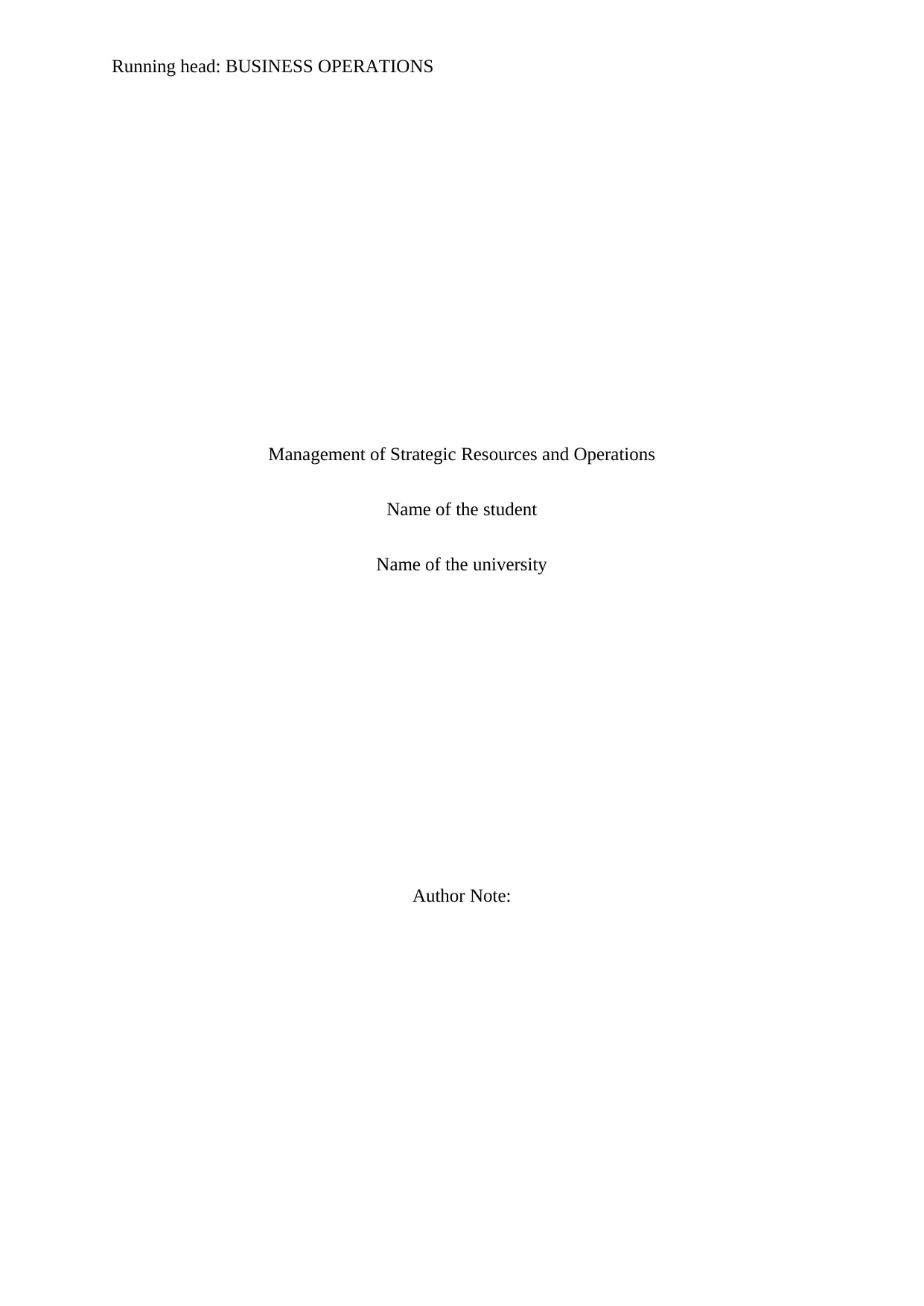
Running head: BUSINESS OPERATIONS
Management of Strategic Resources and Operations
Name of the student
Name of the university
Author Note:
Management of Strategic Resources and Operations
Name of the student
Name of the university
Author Note:
Paraphrase This Document
Need a fresh take? Get an instant paraphrase of this document with our AI Paraphraser
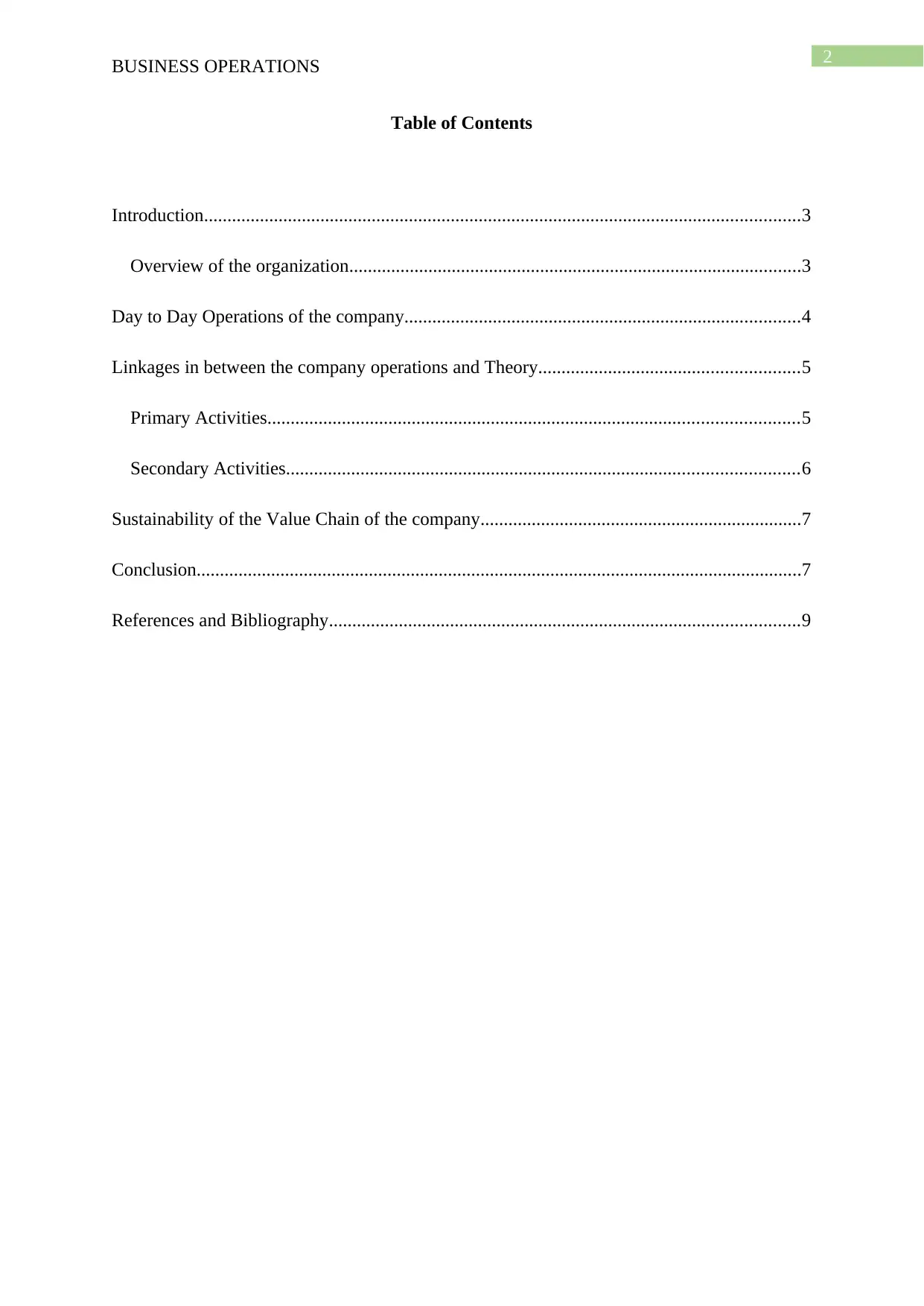
2
BUSINESS OPERATIONS
Table of Contents
Introduction................................................................................................................................3
Overview of the organization.................................................................................................3
Day to Day Operations of the company.....................................................................................4
Linkages in between the company operations and Theory........................................................5
Primary Activities..................................................................................................................5
Secondary Activities..............................................................................................................6
Sustainability of the Value Chain of the company.....................................................................7
Conclusion..................................................................................................................................7
References and Bibliography.....................................................................................................9
BUSINESS OPERATIONS
Table of Contents
Introduction................................................................................................................................3
Overview of the organization.................................................................................................3
Day to Day Operations of the company.....................................................................................4
Linkages in between the company operations and Theory........................................................5
Primary Activities..................................................................................................................5
Secondary Activities..............................................................................................................6
Sustainability of the Value Chain of the company.....................................................................7
Conclusion..................................................................................................................................7
References and Bibliography.....................................................................................................9
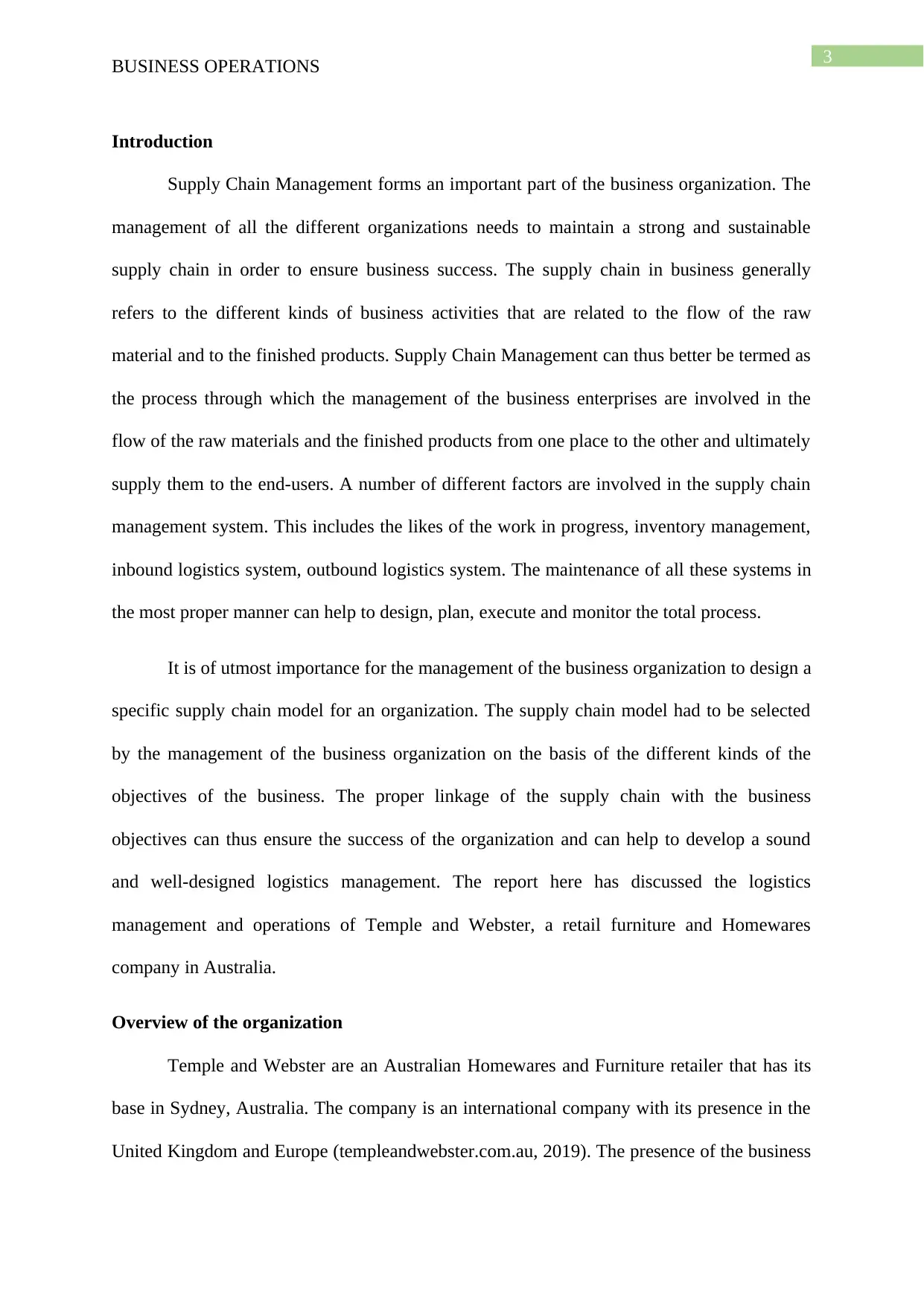
3
BUSINESS OPERATIONS
Introduction
Supply Chain Management forms an important part of the business organization. The
management of all the different organizations needs to maintain a strong and sustainable
supply chain in order to ensure business success. The supply chain in business generally
refers to the different kinds of business activities that are related to the flow of the raw
material and to the finished products. Supply Chain Management can thus better be termed as
the process through which the management of the business enterprises are involved in the
flow of the raw materials and the finished products from one place to the other and ultimately
supply them to the end-users. A number of different factors are involved in the supply chain
management system. This includes the likes of the work in progress, inventory management,
inbound logistics system, outbound logistics system. The maintenance of all these systems in
the most proper manner can help to design, plan, execute and monitor the total process.
It is of utmost importance for the management of the business organization to design a
specific supply chain model for an organization. The supply chain model had to be selected
by the management of the business organization on the basis of the different kinds of the
objectives of the business. The proper linkage of the supply chain with the business
objectives can thus ensure the success of the organization and can help to develop a sound
and well-designed logistics management. The report here has discussed the logistics
management and operations of Temple and Webster, a retail furniture and Homewares
company in Australia.
Overview of the organization
Temple and Webster are an Australian Homewares and Furniture retailer that has its
base in Sydney, Australia. The company is an international company with its presence in the
United Kingdom and Europe (templeandwebster.com.au, 2019). The presence of the business
BUSINESS OPERATIONS
Introduction
Supply Chain Management forms an important part of the business organization. The
management of all the different organizations needs to maintain a strong and sustainable
supply chain in order to ensure business success. The supply chain in business generally
refers to the different kinds of business activities that are related to the flow of the raw
material and to the finished products. Supply Chain Management can thus better be termed as
the process through which the management of the business enterprises are involved in the
flow of the raw materials and the finished products from one place to the other and ultimately
supply them to the end-users. A number of different factors are involved in the supply chain
management system. This includes the likes of the work in progress, inventory management,
inbound logistics system, outbound logistics system. The maintenance of all these systems in
the most proper manner can help to design, plan, execute and monitor the total process.
It is of utmost importance for the management of the business organization to design a
specific supply chain model for an organization. The supply chain model had to be selected
by the management of the business organization on the basis of the different kinds of the
objectives of the business. The proper linkage of the supply chain with the business
objectives can thus ensure the success of the organization and can help to develop a sound
and well-designed logistics management. The report here has discussed the logistics
management and operations of Temple and Webster, a retail furniture and Homewares
company in Australia.
Overview of the organization
Temple and Webster are an Australian Homewares and Furniture retailer that has its
base in Sydney, Australia. The company is an international company with its presence in the
United Kingdom and Europe (templeandwebster.com.au, 2019). The presence of the business
⊘ This is a preview!⊘
Do you want full access?
Subscribe today to unlock all pages.

Trusted by 1+ million students worldwide
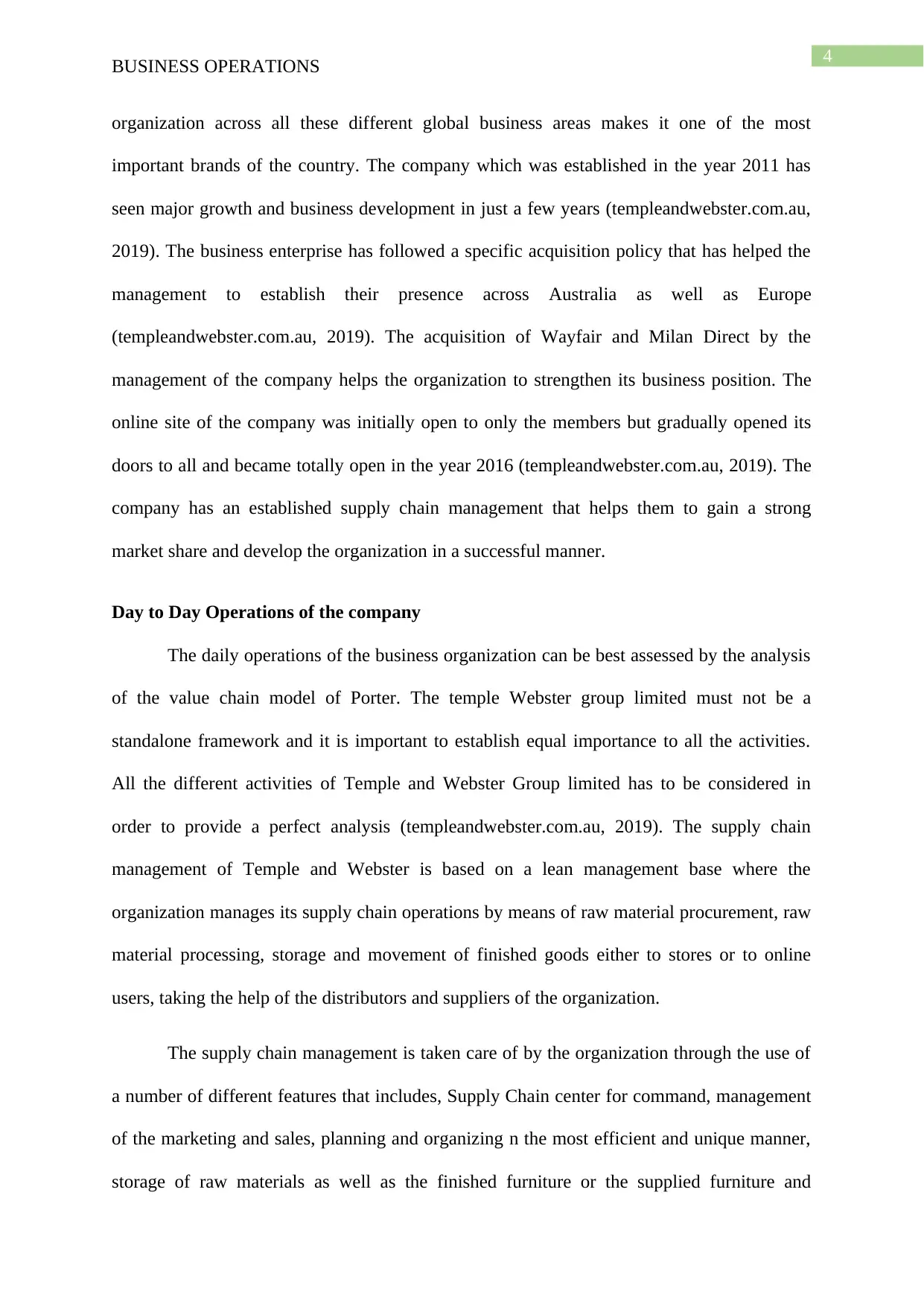
4
BUSINESS OPERATIONS
organization across all these different global business areas makes it one of the most
important brands of the country. The company which was established in the year 2011 has
seen major growth and business development in just a few years (templeandwebster.com.au,
2019). The business enterprise has followed a specific acquisition policy that has helped the
management to establish their presence across Australia as well as Europe
(templeandwebster.com.au, 2019). The acquisition of Wayfair and Milan Direct by the
management of the company helps the organization to strengthen its business position. The
online site of the company was initially open to only the members but gradually opened its
doors to all and became totally open in the year 2016 (templeandwebster.com.au, 2019). The
company has an established supply chain management that helps them to gain a strong
market share and develop the organization in a successful manner.
Day to Day Operations of the company
The daily operations of the business organization can be best assessed by the analysis
of the value chain model of Porter. The temple Webster group limited must not be a
standalone framework and it is important to establish equal importance to all the activities.
All the different activities of Temple and Webster Group limited has to be considered in
order to provide a perfect analysis (templeandwebster.com.au, 2019). The supply chain
management of Temple and Webster is based on a lean management base where the
organization manages its supply chain operations by means of raw material procurement, raw
material processing, storage and movement of finished goods either to stores or to online
users, taking the help of the distributors and suppliers of the organization.
The supply chain management is taken care of by the organization through the use of
a number of different features that includes, Supply Chain center for command, management
of the marketing and sales, planning and organizing n the most efficient and unique manner,
storage of raw materials as well as the finished furniture or the supplied furniture and
BUSINESS OPERATIONS
organization across all these different global business areas makes it one of the most
important brands of the country. The company which was established in the year 2011 has
seen major growth and business development in just a few years (templeandwebster.com.au,
2019). The business enterprise has followed a specific acquisition policy that has helped the
management to establish their presence across Australia as well as Europe
(templeandwebster.com.au, 2019). The acquisition of Wayfair and Milan Direct by the
management of the company helps the organization to strengthen its business position. The
online site of the company was initially open to only the members but gradually opened its
doors to all and became totally open in the year 2016 (templeandwebster.com.au, 2019). The
company has an established supply chain management that helps them to gain a strong
market share and develop the organization in a successful manner.
Day to Day Operations of the company
The daily operations of the business organization can be best assessed by the analysis
of the value chain model of Porter. The temple Webster group limited must not be a
standalone framework and it is important to establish equal importance to all the activities.
All the different activities of Temple and Webster Group limited has to be considered in
order to provide a perfect analysis (templeandwebster.com.au, 2019). The supply chain
management of Temple and Webster is based on a lean management base where the
organization manages its supply chain operations by means of raw material procurement, raw
material processing, storage and movement of finished goods either to stores or to online
users, taking the help of the distributors and suppliers of the organization.
The supply chain management is taken care of by the organization through the use of
a number of different features that includes, Supply Chain center for command, management
of the marketing and sales, planning and organizing n the most efficient and unique manner,
storage of raw materials as well as the finished furniture or the supplied furniture and
Paraphrase This Document
Need a fresh take? Get an instant paraphrase of this document with our AI Paraphraser
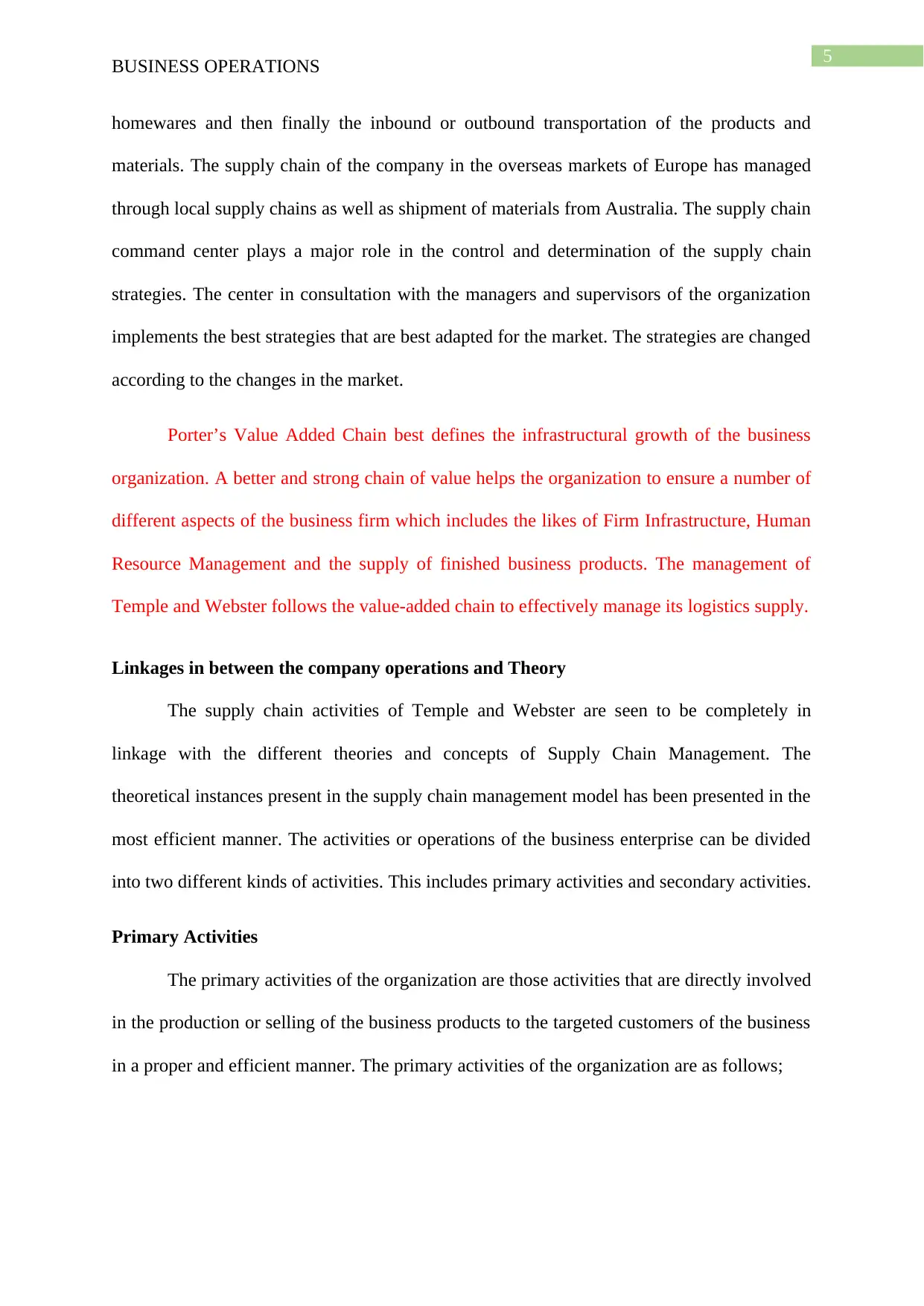
5
BUSINESS OPERATIONS
homewares and then finally the inbound or outbound transportation of the products and
materials. The supply chain of the company in the overseas markets of Europe has managed
through local supply chains as well as shipment of materials from Australia. The supply chain
command center plays a major role in the control and determination of the supply chain
strategies. The center in consultation with the managers and supervisors of the organization
implements the best strategies that are best adapted for the market. The strategies are changed
according to the changes in the market.
Porter’s Value Added Chain best defines the infrastructural growth of the business
organization. A better and strong chain of value helps the organization to ensure a number of
different aspects of the business firm which includes the likes of Firm Infrastructure, Human
Resource Management and the supply of finished business products. The management of
Temple and Webster follows the value-added chain to effectively manage its logistics supply.
Linkages in between the company operations and Theory
The supply chain activities of Temple and Webster are seen to be completely in
linkage with the different theories and concepts of Supply Chain Management. The
theoretical instances present in the supply chain management model has been presented in the
most efficient manner. The activities or operations of the business enterprise can be divided
into two different kinds of activities. This includes primary activities and secondary activities.
Primary Activities
The primary activities of the organization are those activities that are directly involved
in the production or selling of the business products to the targeted customers of the business
in a proper and efficient manner. The primary activities of the organization are as follows;
BUSINESS OPERATIONS
homewares and then finally the inbound or outbound transportation of the products and
materials. The supply chain of the company in the overseas markets of Europe has managed
through local supply chains as well as shipment of materials from Australia. The supply chain
command center plays a major role in the control and determination of the supply chain
strategies. The center in consultation with the managers and supervisors of the organization
implements the best strategies that are best adapted for the market. The strategies are changed
according to the changes in the market.
Porter’s Value Added Chain best defines the infrastructural growth of the business
organization. A better and strong chain of value helps the organization to ensure a number of
different aspects of the business firm which includes the likes of Firm Infrastructure, Human
Resource Management and the supply of finished business products. The management of
Temple and Webster follows the value-added chain to effectively manage its logistics supply.
Linkages in between the company operations and Theory
The supply chain activities of Temple and Webster are seen to be completely in
linkage with the different theories and concepts of Supply Chain Management. The
theoretical instances present in the supply chain management model has been presented in the
most efficient manner. The activities or operations of the business enterprise can be divided
into two different kinds of activities. This includes primary activities and secondary activities.
Primary Activities
The primary activities of the organization are those activities that are directly involved
in the production or selling of the business products to the targeted customers of the business
in a proper and efficient manner. The primary activities of the organization are as follows;
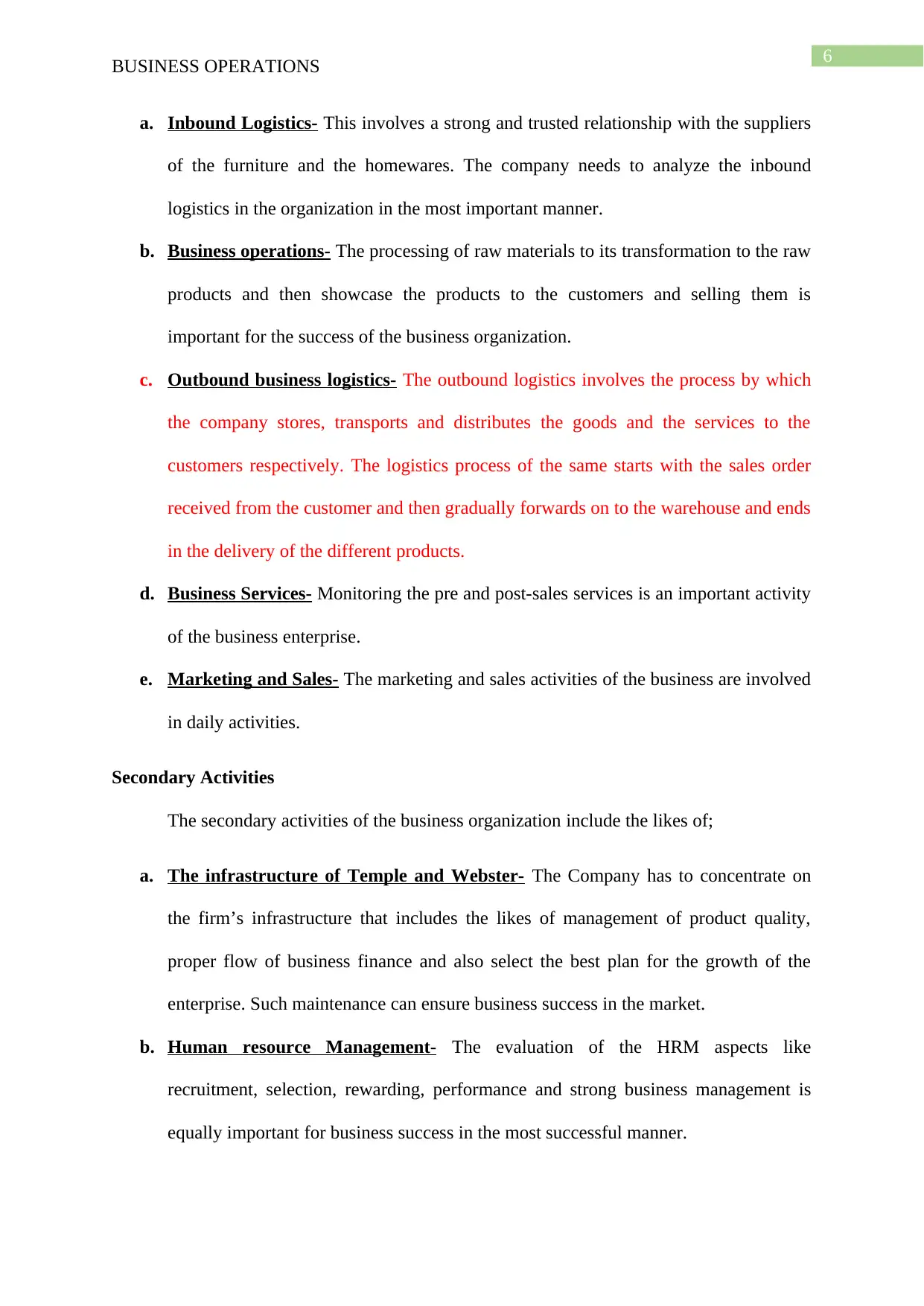
6
BUSINESS OPERATIONS
a. Inbound Logistics- This involves a strong and trusted relationship with the suppliers
of the furniture and the homewares. The company needs to analyze the inbound
logistics in the organization in the most important manner.
b. Business operations- The processing of raw materials to its transformation to the raw
products and then showcase the products to the customers and selling them is
important for the success of the business organization.
c. Outbound business logistics- The outbound logistics involves the process by which
the company stores, transports and distributes the goods and the services to the
customers respectively. The logistics process of the same starts with the sales order
received from the customer and then gradually forwards on to the warehouse and ends
in the delivery of the different products.
d. Business Services- Monitoring the pre and post-sales services is an important activity
of the business enterprise.
e. Marketing and Sales- The marketing and sales activities of the business are involved
in daily activities.
Secondary Activities
The secondary activities of the business organization include the likes of;
a. The infrastructure of Temple and Webster- The Company has to concentrate on
the firm’s infrastructure that includes the likes of management of product quality,
proper flow of business finance and also select the best plan for the growth of the
enterprise. Such maintenance can ensure business success in the market.
b. Human resource Management- The evaluation of the HRM aspects like
recruitment, selection, rewarding, performance and strong business management is
equally important for business success in the most successful manner.
BUSINESS OPERATIONS
a. Inbound Logistics- This involves a strong and trusted relationship with the suppliers
of the furniture and the homewares. The company needs to analyze the inbound
logistics in the organization in the most important manner.
b. Business operations- The processing of raw materials to its transformation to the raw
products and then showcase the products to the customers and selling them is
important for the success of the business organization.
c. Outbound business logistics- The outbound logistics involves the process by which
the company stores, transports and distributes the goods and the services to the
customers respectively. The logistics process of the same starts with the sales order
received from the customer and then gradually forwards on to the warehouse and ends
in the delivery of the different products.
d. Business Services- Monitoring the pre and post-sales services is an important activity
of the business enterprise.
e. Marketing and Sales- The marketing and sales activities of the business are involved
in daily activities.
Secondary Activities
The secondary activities of the business organization include the likes of;
a. The infrastructure of Temple and Webster- The Company has to concentrate on
the firm’s infrastructure that includes the likes of management of product quality,
proper flow of business finance and also select the best plan for the growth of the
enterprise. Such maintenance can ensure business success in the market.
b. Human resource Management- The evaluation of the HRM aspects like
recruitment, selection, rewarding, performance and strong business management is
equally important for business success in the most successful manner.
⊘ This is a preview!⊘
Do you want full access?
Subscribe today to unlock all pages.

Trusted by 1+ million students worldwide
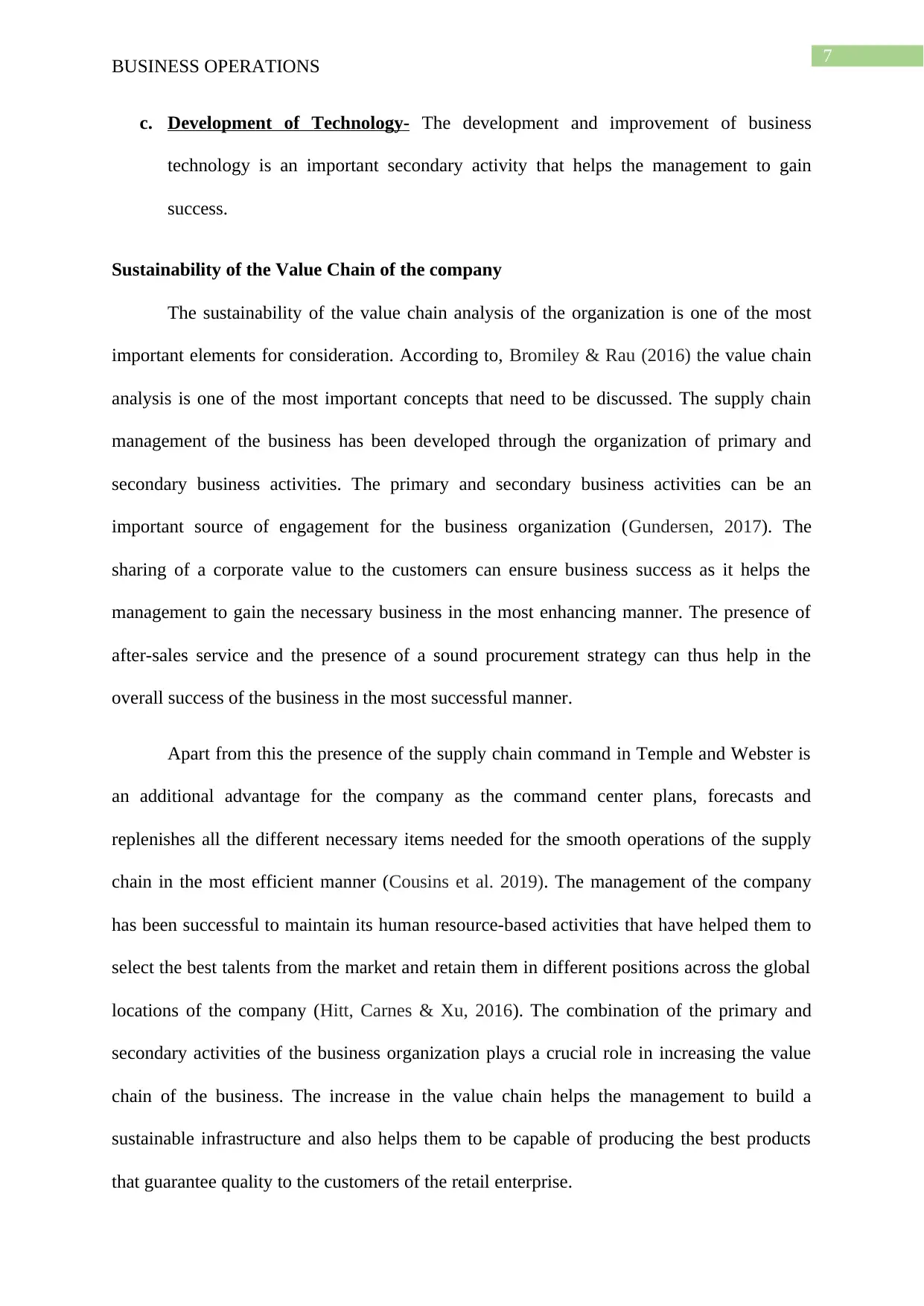
7
BUSINESS OPERATIONS
c. Development of Technology- The development and improvement of business
technology is an important secondary activity that helps the management to gain
success.
Sustainability of the Value Chain of the company
The sustainability of the value chain analysis of the organization is one of the most
important elements for consideration. According to, Bromiley & Rau (2016) the value chain
analysis is one of the most important concepts that need to be discussed. The supply chain
management of the business has been developed through the organization of primary and
secondary business activities. The primary and secondary business activities can be an
important source of engagement for the business organization (Gundersen, 2017). The
sharing of a corporate value to the customers can ensure business success as it helps the
management to gain the necessary business in the most enhancing manner. The presence of
after-sales service and the presence of a sound procurement strategy can thus help in the
overall success of the business in the most successful manner.
Apart from this the presence of the supply chain command in Temple and Webster is
an additional advantage for the company as the command center plans, forecasts and
replenishes all the different necessary items needed for the smooth operations of the supply
chain in the most efficient manner (Cousins et al. 2019). The management of the company
has been successful to maintain its human resource-based activities that have helped them to
select the best talents from the market and retain them in different positions across the global
locations of the company (Hitt, Carnes & Xu, 2016). The combination of the primary and
secondary activities of the business organization plays a crucial role in increasing the value
chain of the business. The increase in the value chain helps the management to build a
sustainable infrastructure and also helps them to be capable of producing the best products
that guarantee quality to the customers of the retail enterprise.
BUSINESS OPERATIONS
c. Development of Technology- The development and improvement of business
technology is an important secondary activity that helps the management to gain
success.
Sustainability of the Value Chain of the company
The sustainability of the value chain analysis of the organization is one of the most
important elements for consideration. According to, Bromiley & Rau (2016) the value chain
analysis is one of the most important concepts that need to be discussed. The supply chain
management of the business has been developed through the organization of primary and
secondary business activities. The primary and secondary business activities can be an
important source of engagement for the business organization (Gundersen, 2017). The
sharing of a corporate value to the customers can ensure business success as it helps the
management to gain the necessary business in the most enhancing manner. The presence of
after-sales service and the presence of a sound procurement strategy can thus help in the
overall success of the business in the most successful manner.
Apart from this the presence of the supply chain command in Temple and Webster is
an additional advantage for the company as the command center plans, forecasts and
replenishes all the different necessary items needed for the smooth operations of the supply
chain in the most efficient manner (Cousins et al. 2019). The management of the company
has been successful to maintain its human resource-based activities that have helped them to
select the best talents from the market and retain them in different positions across the global
locations of the company (Hitt, Carnes & Xu, 2016). The combination of the primary and
secondary activities of the business organization plays a crucial role in increasing the value
chain of the business. The increase in the value chain helps the management to build a
sustainable infrastructure and also helps them to be capable of producing the best products
that guarantee quality to the customers of the retail enterprise.
Paraphrase This Document
Need a fresh take? Get an instant paraphrase of this document with our AI Paraphraser
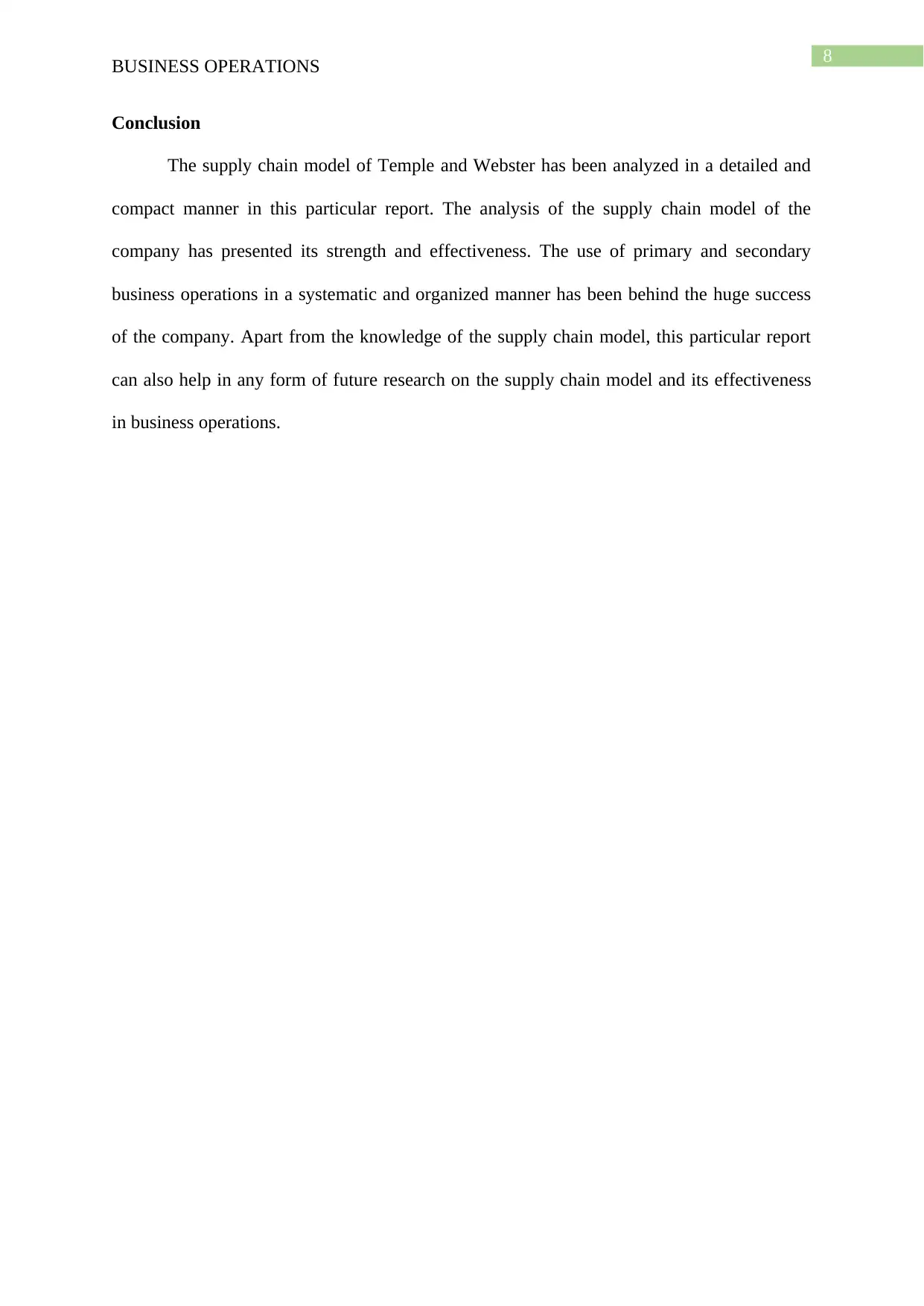
8
BUSINESS OPERATIONS
Conclusion
The supply chain model of Temple and Webster has been analyzed in a detailed and
compact manner in this particular report. The analysis of the supply chain model of the
company has presented its strength and effectiveness. The use of primary and secondary
business operations in a systematic and organized manner has been behind the huge success
of the company. Apart from the knowledge of the supply chain model, this particular report
can also help in any form of future research on the supply chain model and its effectiveness
in business operations.
BUSINESS OPERATIONS
Conclusion
The supply chain model of Temple and Webster has been analyzed in a detailed and
compact manner in this particular report. The analysis of the supply chain model of the
company has presented its strength and effectiveness. The use of primary and secondary
business operations in a systematic and organized manner has been behind the huge success
of the company. Apart from the knowledge of the supply chain model, this particular report
can also help in any form of future research on the supply chain model and its effectiveness
in business operations.
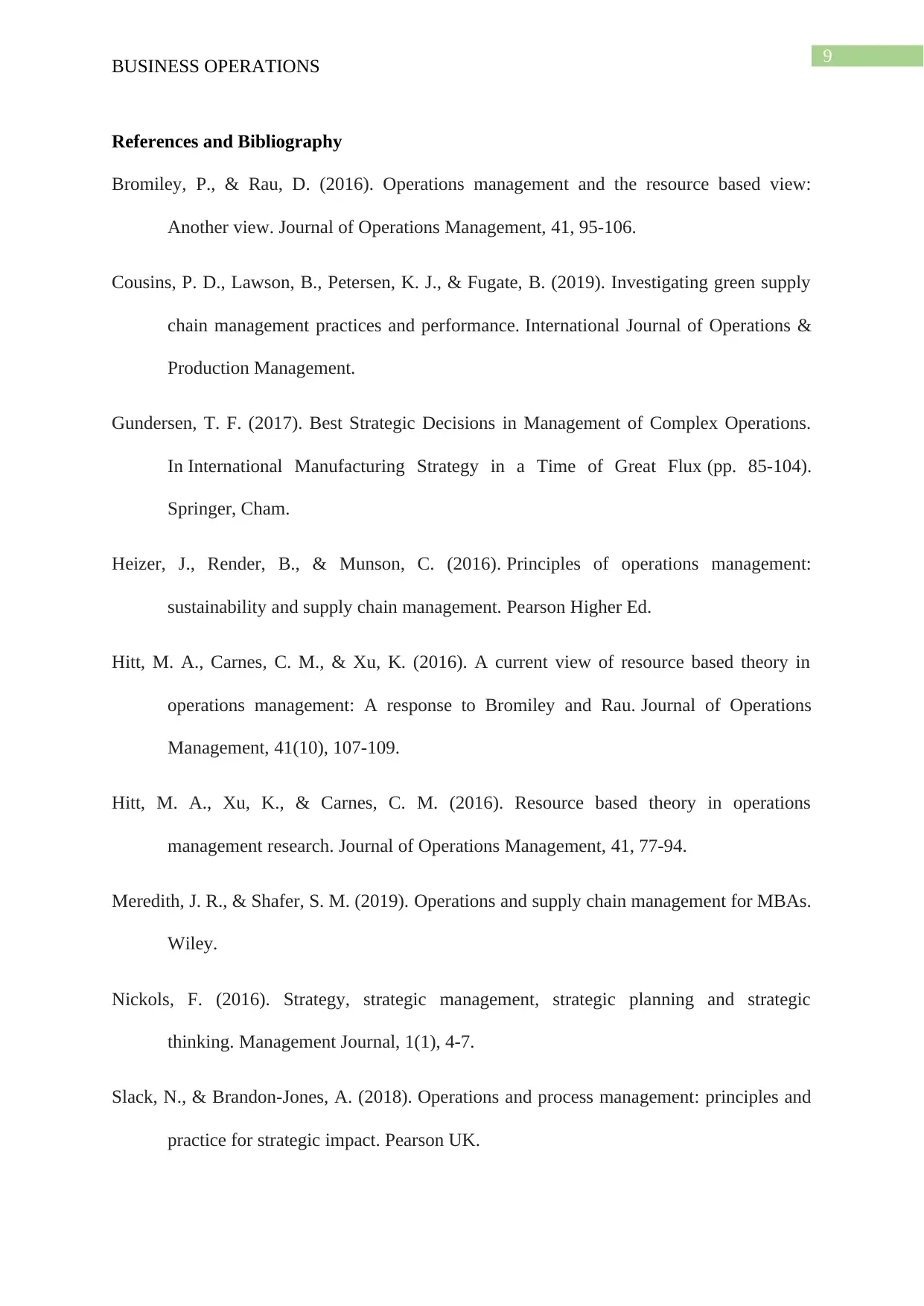
9
BUSINESS OPERATIONS
References and Bibliography
Bromiley, P., & Rau, D. (2016). Operations management and the resource based view:
Another view. Journal of Operations Management, 41, 95-106.
Cousins, P. D., Lawson, B., Petersen, K. J., & Fugate, B. (2019). Investigating green supply
chain management practices and performance. International Journal of Operations &
Production Management.
Gundersen, T. F. (2017). Best Strategic Decisions in Management of Complex Operations.
In International Manufacturing Strategy in a Time of Great Flux (pp. 85-104).
Springer, Cham.
Heizer, J., Render, B., & Munson, C. (2016). Principles of operations management:
sustainability and supply chain management. Pearson Higher Ed.
Hitt, M. A., Carnes, C. M., & Xu, K. (2016). A current view of resource based theory in
operations management: A response to Bromiley and Rau. Journal of Operations
Management, 41(10), 107-109.
Hitt, M. A., Xu, K., & Carnes, C. M. (2016). Resource based theory in operations
management research. Journal of Operations Management, 41, 77-94.
Meredith, J. R., & Shafer, S. M. (2019). Operations and supply chain management for MBAs.
Wiley.
Nickols, F. (2016). Strategy, strategic management, strategic planning and strategic
thinking. Management Journal, 1(1), 4-7.
Slack, N., & Brandon-Jones, A. (2018). Operations and process management: principles and
practice for strategic impact. Pearson UK.
BUSINESS OPERATIONS
References and Bibliography
Bromiley, P., & Rau, D. (2016). Operations management and the resource based view:
Another view. Journal of Operations Management, 41, 95-106.
Cousins, P. D., Lawson, B., Petersen, K. J., & Fugate, B. (2019). Investigating green supply
chain management practices and performance. International Journal of Operations &
Production Management.
Gundersen, T. F. (2017). Best Strategic Decisions in Management of Complex Operations.
In International Manufacturing Strategy in a Time of Great Flux (pp. 85-104).
Springer, Cham.
Heizer, J., Render, B., & Munson, C. (2016). Principles of operations management:
sustainability and supply chain management. Pearson Higher Ed.
Hitt, M. A., Carnes, C. M., & Xu, K. (2016). A current view of resource based theory in
operations management: A response to Bromiley and Rau. Journal of Operations
Management, 41(10), 107-109.
Hitt, M. A., Xu, K., & Carnes, C. M. (2016). Resource based theory in operations
management research. Journal of Operations Management, 41, 77-94.
Meredith, J. R., & Shafer, S. M. (2019). Operations and supply chain management for MBAs.
Wiley.
Nickols, F. (2016). Strategy, strategic management, strategic planning and strategic
thinking. Management Journal, 1(1), 4-7.
Slack, N., & Brandon-Jones, A. (2018). Operations and process management: principles and
practice for strategic impact. Pearson UK.
⊘ This is a preview!⊘
Do you want full access?
Subscribe today to unlock all pages.

Trusted by 1+ million students worldwide

10
BUSINESS OPERATIONS
templeandwebster.com.au (2020). Retrieved 25 January 2020, from
https://www.templeandwebster.com.au/
BUSINESS OPERATIONS
templeandwebster.com.au (2020). Retrieved 25 January 2020, from
https://www.templeandwebster.com.au/
1 out of 10
Related Documents
Your All-in-One AI-Powered Toolkit for Academic Success.
+13062052269
info@desklib.com
Available 24*7 on WhatsApp / Email
![[object Object]](/_next/static/media/star-bottom.7253800d.svg)
Unlock your academic potential
Copyright © 2020–2025 A2Z Services. All Rights Reserved. Developed and managed by ZUCOL.





